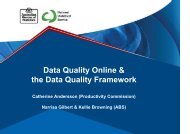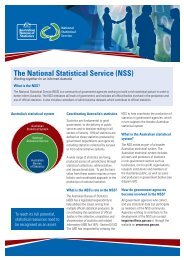SAE Manual Sections 1 to 4_1 (May 06).pdf - National Statistical ...
SAE Manual Sections 1 to 4_1 (May 06).pdf - National Statistical ...
SAE Manual Sections 1 to 4_1 (May 06).pdf - National Statistical ...
Create successful ePaper yourself
Turn your PDF publications into a flip-book with our unique Google optimized e-Paper software.
A Guide <strong>to</strong> Small Area Estimation - Version 1.1 05/05/20<strong>06</strong><br />
fine geographic and level of detail as compared <strong>to</strong> psychological disability (which is<br />
around 1%). This choice also depends on the quality of data which is discussed in the<br />
next section.<br />
D) What are the consequences for users’ decision making outcomes if the<br />
small area data is incorrect, say, by 5%, 10%, 20%, etc? Which small<br />
area estimates have the greatest priority in terms of accuracy<br />
requirements?<br />
The answer <strong>to</strong> this question will drive the level of quality and hence resources required<br />
<strong>to</strong> produce small area estimates of acceptable quality <strong>to</strong> users. If large funds from a<br />
government program are <strong>to</strong> be allocated <strong>to</strong> regions based on the small area estimates,<br />
then a high level of quality assurance and validation is required. However, if all that is<br />
required is an approximate guide <strong>to</strong> indicate areas where there may be unmet need, say<br />
for program evaluation purposes, then broad quality checks may be adequate.<br />
To assess how accurate small area estimates need <strong>to</strong> be before they start <strong>to</strong> adversely<br />
impact upon decision making outcomes, it is important <strong>to</strong> understand the entire<br />
decision making process and the way in which small area estimates feeding in<strong>to</strong> that<br />
process impact upon the outputs. This involves understanding the assumptions implicit<br />
in the process. The analyst needs <strong>to</strong> work out, in consultation with users, how accurate<br />
final decision making outcomes need <strong>to</strong> be. By working backwards, it may be possible<br />
<strong>to</strong> work out what level of accuracy in the small areas estimates will give this level of<br />
accuracy in the decision making outcomes. A sensitivity analysis is another approach<br />
that can also be undertaken <strong>to</strong> determine how sensitive final decisions are <strong>to</strong> changes in<br />
the small area estimates.<br />
Zaslavsky and Schirm (2002) discuss, in the context of funding allocations, how<br />
interactions between the provisions of the funding formula, data sources and estimation<br />
procedures used <strong>to</strong> derive formula inputs can have unanticipated consequences that are<br />
inconsistent with the policy goals of a program.<br />
E) Are there any conceptual models, either social or economic, that are<br />
believed <strong>to</strong> describe the process which influences the variable(s) for<br />
which we are <strong>to</strong> calculate small area estimates<br />
This is a great opportunity <strong>to</strong> get expert advice on what variables should have a<br />
relationship with the population of interest. This will give a theoretical base <strong>to</strong> look at<br />
certain variables which can then be confirmed by statistical analysis. A widely accepted<br />
theoretical model or framework, published in the literature and/or supported by<br />
empirical investigations can greatly assist in deciding which variables, interaction terms<br />
and contextual effects should be included in the small area model or in validating the<br />
predicted estimates. Should you decide <strong>to</strong> include other variables not included in the<br />
framework or exclude variables that are included, you are aware of the potential need <strong>to</strong><br />
justify the decision.<br />
Australian Bureau of Statistics 12








